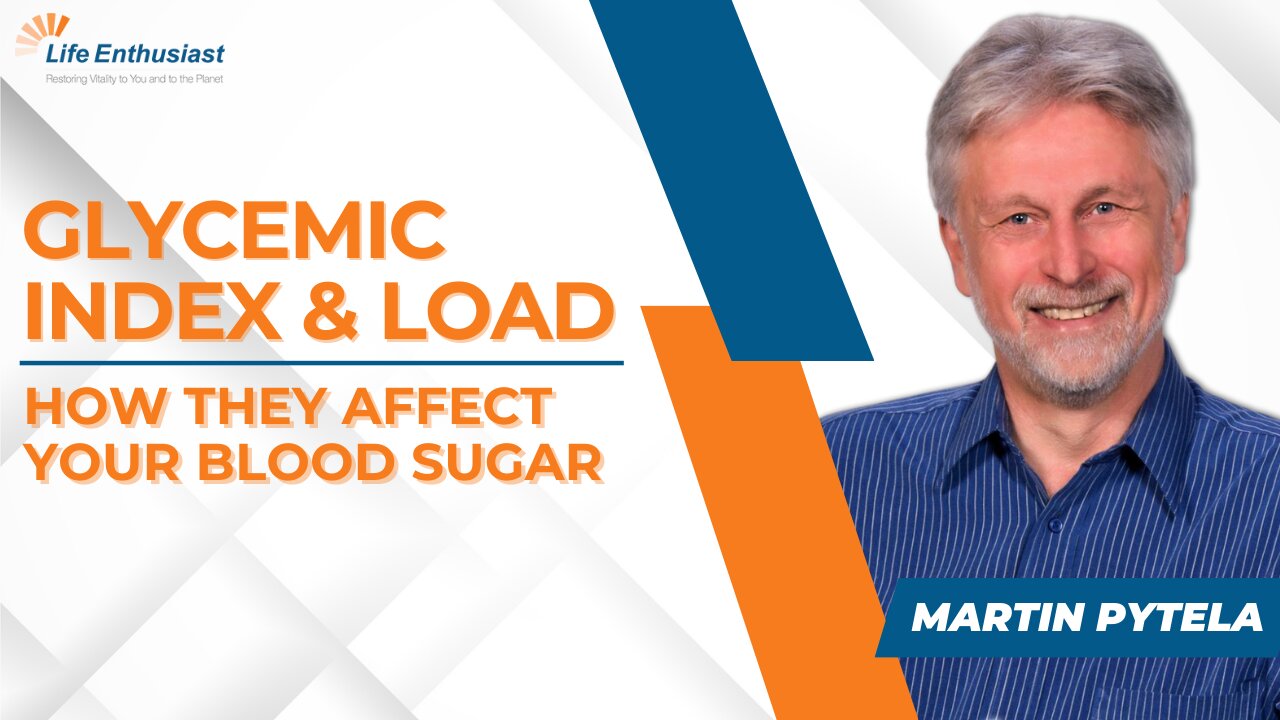Premium Only Content

How Glycemic Index and Glycemic Load Affect Your Blood Sugar
#LifeEnthusiast #health #wellness
When it comes to managing blood sugar levels and making informed dietary choices, understanding the concepts of glycemic index (GI) and glycemic load (GL) is paramount. These metrics serve as essential tools for individuals looking to optimize their health, particularly those managing diabetes or insulin resistance. Let's delve into these two measures, their differences, and their implications for your diet.
What is the Glycemic Index (GI)?
The glycemic index is a ranking system for carbohydrates based on their immediate effect on blood glucose levels. It compares foods to a standard reference, typically pure glucose or white bread, which is assigned a GI of 100. Foods are then scored on a scale from 0 to 100:
- High GI Foods (70-100): These cause a rapid increase in blood glucose levels. Examples include white bread, potatoes, and sugary snacks.
- Medium GI Foods (56-69): These have a moderate effect on blood sugar levels. Such foods include whole wheat products and some fruits like pineapple.
- Low GI Foods (0-55): These result in a slower, more gradual rise in blood glucose levels. Examples include oats, legumes, and most vegetables.
Understanding the glycemic index can help you make better food choices by identifying which foods are likely to cause spikes in your blood sugar.
What is Glycemic Load (GL)?
While the glycemic index offers valuable insights into how quickly a food can raise blood glucose levels, it doesn't account for the quantity of carbohydrates in a typical serving. This is where glycemic load comes in, as it provides a more comprehensive picture by considering both the quality (GI) and quantity of carbohydrates in a food. The formula to calculate GL is:
GL = (GI x Carbohydrate Content of Serving (grams))/100
Glycemic load better predicts a food's overall impact on blood sugar levels. For instance, a small serving of a high-GI food may have a lower GL and thus a lesser effect on blood glucose compared to a large serving of a low-GI food. Foods are categorized as follows based on their GL:
- High GL (20 and above)
- Medium GL (11-19)
- Low GL (10 and below)
Key Differences Between GI and GL
1. Measurement Focus:
- GI measures the rate at which carbohydrates in food raise blood glucose levels.
- GL takes into account both the rate and the total carbohydrate content in a typical serving size.
2. Portion Size:
- GI does not consider the amount of food consumed.
- GL provides a more practical assessment by factoring in the portion size, giving a clear picture of the overall glycemic impact of a meal.
3. Practicality:
- GI is easier to understand and use in quick decision-making but can be misleading if portion sizes are not considered.
- GL offers more accuracy for managing blood sugar levels over an entire meal or diet plan.
Practical Implications for Your Diet
Selecting Low-GI Foods
Opting for low-GI foods can help keep your blood sugar levels more stable. Examples of low-GI foods include:
- Legumes: Beans, lentils, and chickpeas
- Whole Grains: Barley, quinoa, and oats
- Vegetables: Leafy greens, broccoli, and carrots
These foods don't cause rapid spikes in blood glucose, making them ideal for sustained energy levels throughout the day.
To manage your glycemic load effectively, you can combine low-GI foods with those that have high-GI but are consumed in smaller quantities. For example, pairing white rice (high GI) with lentils (low GI) can balance out the meal's overall GL.
Understanding GL emphasizes the importance of portion size. Eating large amounts of medium-GI foods can result in a high glycemic load, which is not conducive to stable blood sugar levels. Practice portion control to maintain a balanced diet.
Both glycemic index and glycemic load are valuable tools for managing blood sugar levels and making informed dietary decisions. While GI provides a quick understanding of how fast a carbohydrate can raise blood glucose levels, GL offers a more nuanced approach by considering portion sizes. By integrating both concepts, you can make smarter choices that contribute to better health and sustained energy levels. Remember, the key to effective dietary planning lies in the balance and moderation of the foods you consume.
Connect With us:
Website:
https://www.life-enthusiast.com/
https://www.life-enthusiast.com/articles/product_brand/exsula-superfoods?utm_campaign=cherub&utm_medium=youtube&utm_source=exsula-superfoods
Facebook:
https://www.facebook.com/LifeEnthusiastContact
Twitter:
https://twitter.com/lifentco
Youtube:
https://www.youtube.com/user/lifentco
Rumble:
https://rumble.com/user/lifeenthusiastcoop
#LifeEnthusiast #health #wellness #podcasts #education #homeopathy
#HighQualityIngredients #NextLevelHealth #SupplementSupport #HerbalHealing #HollisticWellness #NaturalRemedies #AlternativeHealth #TraditionalMedicine #HealthJourney #WellnessSolution #HealthAndWellness #HealthyLiving #HealingPath
-
 LIVE
LIVE
The White House
1 hour agoPress Secretary Karoline Leavitt Briefs Members of the Media, Nov. 20, 2025
812 watching -
 2:06:37
2:06:37
Steven Crowder
3 hours agoJasmine Crockett's Epstein Idiocy & the Absolute State of the Democrat Party
294K194 -
 LIVE
LIVE
Sean Unpaved
1 hour agoAre Josh Allen & Bills On UPSET ALERT vs. Texans? | UNPAVED
77 watching -
 LIVE
LIVE
Side Scrollers Podcast
2 hours agoRoblox Kids TRANS Game + Pokimane ROASTED AGAIN + More | Side Scrollers
829 watching -
 LIVE
LIVE
The Charlie Kirk Show
1 hour agoTP Action Update + Mogadishu Minnesota + Replacing ObamaCare | Bowyer, Thorpe, Cremieux | 11.20.2025
2,812 watching -
 LIVE
LIVE
Right Side Broadcasting Network
3 hours agoLIVE: White House Press Secretary Karoline Leavitt Holds a Press Briefing - 11/20/25
2,719 watching -
 LIVE
LIVE
Rebel News
47 minutes agoCBSA refugee revelation, No oil tankers in BC, Notwithstanding clause debate | Rebel Roundup
225 watching -
 LIVE
LIVE
TheAlecLaceShow
1 hour agoGuests: Scott Jennings, Senator Marsha Blackburn, Del Bigtree | The Alec Lace Show
66 watching -
 1:01:04
1:01:04
The Rubin Report
2 hours agoThe Exact Moment CNN Host Realizes Jasmine Crockett Is a Monster
16.9K58 -
 LIVE
LIVE
LFA TV
15 hours agoLIVE & BREAKING NEWS! | THURSDAY 11/20/25
2,454 watching